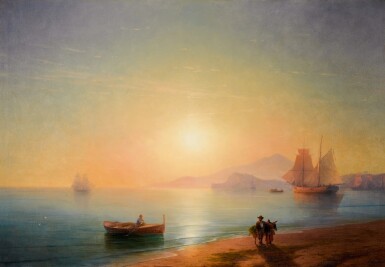Russian Pictures
Russian Pictures

Property from a Private European Collection
IVAN KONSTANTINOVICH AIVAZOVSKY | THE BAY OF NAPLES
Lot Closed
June 2, 01:37 PM GMT
Estimate
800,000 - 1,200,000 GBP
Lot Details
Description
Property from a Private European Collection
IVAN KONSTANTINOVICH AIVAZOVSKY
1817-1900
THE BAY OF NAPLES
signed in Cyrillic and dated 1878 l.r.; further signed and dated on the reverse
oil on canvas
Canvas: 144 by 208.5cm, 56 3/4 by 82in.
Framed: 147.5 by 211.5cm, 58 by 83 1/4 in.
The present work is included in the numbered archive of the artist's work compiled by Gianni Caffiero and Ivan Samarine.
Please note: Condition 11 of the Conditions of Business for Buyers (Online Only) is not applicable to this lot.
To view shipping calculator, please click here
Private collection, Germany
Zurich, Koller Auktionen, 19th Century Paintings, Russian Art, Icons, 19 September 2008, lot 3209
Acquired at the above sale by the present owner
G.Caffiero and I.Samarine, Light, Water and Sky: The Paintings of Ivan Aivazovsky, London: Alexandria Press, 2012, pp.186-187 illustrated; p.304 illustrated and listed as CS-1878-009
G.Caffiero and I.Samarine, Neizvestny Aivazovsky: k 200-letiyu so dnya rozhdeniya, Moscow: SLOVO, 2016, p.201 illustrated; p.377 illustrated and listed as CS-1878-009
By 1878, when Ivan Aivazovsky painted The Bay of Naples, he had not just found fame both in Russia and abroad; he had come to define the genre of seascape painting and redefine its place in Russian art.
At over 2 metres wide the present lot is one of the largest paintings by Aivazovsky to appear on the open market and is instantly recognisable as a work by his hand. It combines many of the elements for which he is best known and which continue to resonate with the public today, more than a century after the artist’s death. These include the diffuse sunlight filling a hazy sky which here occupies two thirds of the canvas, and the reflection of light on the calm, only slightly rippling water.
The sea in all its states, the depiction of its movement, and the play of light on water are the central motifs in Aivazovsky’s oeuvre. He was equally brilliant at depicting stormy seas in dramatic moonlight, often juxtaposing mankind with nature in true Romantic fashion, as at rendering the effects of sunlight on calm water.
Even in his later work, dating from the period when France came under the sway of the Impressionists, Aivazovsky stayed true to his Romantic roots. Early on in his career he had abandoned painting from nature, and he wasn’t interested in capturing the passing effects of light. When working in his studio, he relied on his visual memory and his imagination, claiming that it was impossible to capture the elements with a brush. The role of the artist was to memorise and subsequently use them in his paintings: ‘The subject of a painting takes shape in my mind, just like the subject for a poem in that of a poet’s’ (Quoted in Bulgakov, 1901, p.26).
This also explains why geographical details were secondary for Aivazovsky, and often not accurate; rather he drew on memories gathered over his long life and career. With the warm southern light and the distinctly Italian dress of the figures in the foreground, the present view has been traditionally identified as the coastline of Southern Italy, but the hills are equally reminiscent of the artist’s native Crimea.
